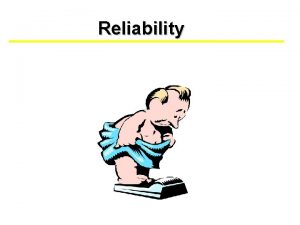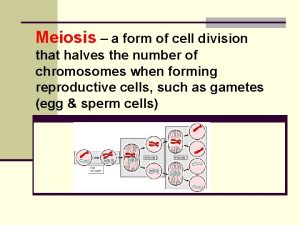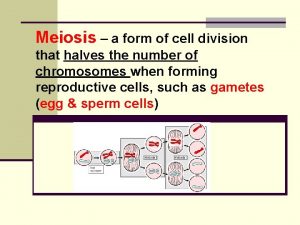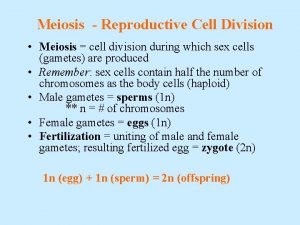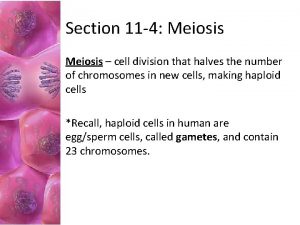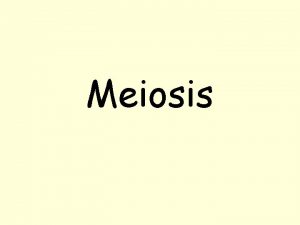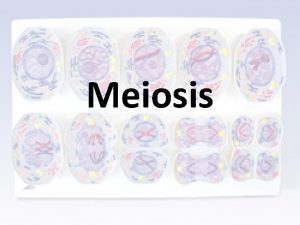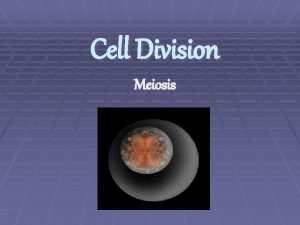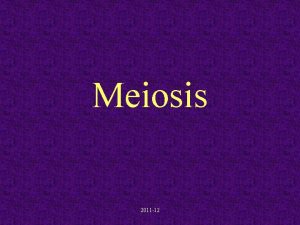Meiosis a form of cell division that halves


















- Slides: 18

Meiosis – a form of cell division that halves the number of chromosomes when forming reproductive cells, such as gametes (egg & sperm cells)

Stages of Meiosis: *Before meiosis begins, DNA in the original cell is replicated. In meiosis, the cell undergoes two cell divisions: Meiosis I and Meiosis II. The cell then goes through two cell divisions: Meiosis I and Meiosis II.

Meiosis I: Homologous chromosomes separate; This stage consists of prophase I, metaphase I, and telophase I.

Meiosis I Diploid 2 n Crossing Over Independent Assortment Haploid n

Prophase I: n chromosomes condense; nuclear envelope breaks down; n homologous chromosomes pair up forming a tetrad (4 chromatids); n crossing over can occur here

Crossing Over Occurs when portions of a chromatid on one homologous chromosome is broken and exchanged with the corresponding chromatid portion of the other homologous chromosome. This leads to genetic variation.

Metaphase I n homologous chromosomes line up in the middle of the cell n independent assortment occurs

Anaphase I n homologous pairs separate

Telophase I n nuclear membrane reforms n two cells are produced each containing 1 set of the homologous pairs n cytokinesis begins (cytoplasm divides)

Meiosis II: The 2 chromatids (referred to as sister chromatids) separate; This stage consists of prophase II, metaphase II, and telophase II.

Meiosis II Haploid n * All 4 cells are genetically different!! Haploid n

Prophase II n a new spindle fibers form around the chromosomes

Metaphase II n sister chromatids line up along the equator n independent assortment occurs

Anaphase II n centromeres divide n sister chromatids separate

Telophase II n nuclear membrane forms around each set of chromosomes n cytokinesis begins (cytoplasm divides) n four haploid cells are produced

Diploid (2 n) Meiosis: -reduces the centromere Crossing-over occurs in Prophase I. Haploid (n) number of chromosomes by half to form gamete cells

Three Mechanisms that Contribute to Genetic Variation: 1. crossing over – when portions of a chromatid on one homologous chromosome is broken and exchanged with the corresponding chromatid portion of the other homologous chromosome 2. independent assortment – the random distribution of homologous chromosomes during meiosis 3. random fertilization – the random joining of 2 gametes

Importance of Genetic Variation: It allows organisms to change so they can better adapt to the changing environment !
 Cell division mitosis and meiosis
Cell division mitosis and meiosis Meiosis
Meiosis Section 10-2 cell division
Section 10-2 cell division Cell cycle and cell division
Cell cycle and cell division Phases of cell cycle
Phases of cell cycle Phân độ lown ngoại tâm thu
Phân độ lown ngoại tâm thu Block nhĩ thất độ 2 mobitz 1
Block nhĩ thất độ 2 mobitz 1 Thơ thất ngôn tứ tuyệt đường luật
Thơ thất ngôn tứ tuyệt đường luật Thơ thất ngôn tứ tuyệt đường luật
Thơ thất ngôn tứ tuyệt đường luật Walmart thất bại ở nhật
Walmart thất bại ở nhật Tìm vết của đường thẳng
Tìm vết của đường thẳng Con hãy đưa tay khi thấy người vấp ngã
Con hãy đưa tay khi thấy người vấp ngã Tôn thất thuyết là ai
Tôn thất thuyết là ai Gây tê cơ vuông thắt lưng
Gây tê cơ vuông thắt lưng Sau thất bại ở hồ điển triệt
Sau thất bại ở hồ điển triệt Softirq vs tasklet
Softirq vs tasklet Test retest reliability
Test retest reliability Kuder richardson 21 formula
Kuder richardson 21 formula Split halves reliability
Split halves reliability
















